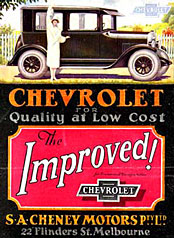 Where it all started for GMH
Where it all started for GMHThey built the bodies on all the
Chassis that were imported
into Australia from America
for many years.
 The original Holden
The original HoldenModel 48-215
Universally known as the FX
All FX and FJ Holdens had
Genuine leather upholstery.
 Holden's second model
Holden's second modelthe FJ, shown here in
utility form.
Our love affair with the ute
rivals that of America's
pickup.
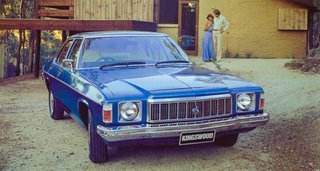 The HX Holden
The HX Holdenthe last one before they
were re-badged as the
Commodore
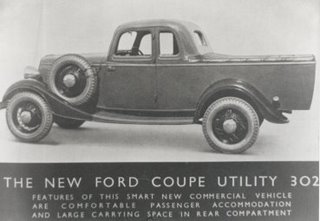 Ford were the first company to
Ford were the first company tomanufacture a utility in 1932.
Prior to that time inventive
farmers had been cutting the
back section from
"Tourer's" and building a
tray section on the back to
carry their farm needs around.
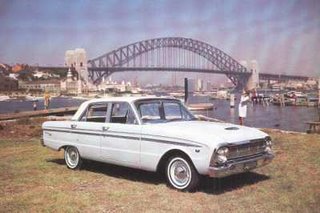 The first Ford Falcon
The first Ford FalconXL model 1961
built as a competitor to
the very popular Holden
Falcon's are still built today.
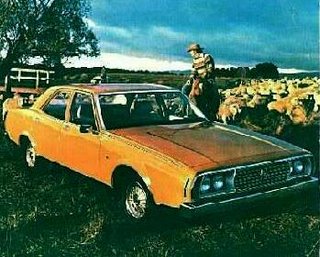
This was the car that
sealed the fate in Australia
for Leyland, although very
innovative in design the
P76 suffered from chronic
build faults that eventually
drove Leyland from our shores.
Some more background stuff.
During, and for some years after World War 2, there was petrol
rationing, dependant on the type of vehicle you drove and your
occupational priorities you were issued with ration tickets which
entitled you to buy petrol to the value of the tickets, no tickets..
no fuel.
Used car “Pegged Prices” There was a Government set price for any
make and model vehicle which was not to be exceeded, all this
managed to do was create a thriving “black market” trade in
secondhand cars, about as effective as Americas prohibition laws.
During World War 2 the practice of jacking cars up to take the weight
off their tyres became popular, lots of women didn’t drive back then
and petrol was very scarce anyway, this became known as “been on
blocks” when the car was put up for sale, it indicated that it had been
unused for the war years and commanded a higher price.
Australia used a method of extending petrol mileage known as
“Gas Producers” these consisted of a fire unit which worked on a
system not unlike a slow combustion fire where the fire of a charcoal
based fuel was fed a minimum amount of oxygen to retard the
burning, the gas that this fire produced was fed into the air intake of
the carburetor where it mixed with or in ideal situations replaced the
petrol fumes.
Fire and Petrol… not a good combination to have close together but
evidently there were very few accidents!!
To help eke out the precious supply of petrol it was not uncommon
to mix a proportion of power kerosene (which was a tractor fuel back
in the days before Diesels) that was a little easier to obtain than
petrol, this mixture needed to be in the right proportions or the car
wouldn’t run very well, if at all.
As the soldiers returned home and things started to get back to
normal there was a severe shortage of motor cars, and with at least
some of the population prepared to stick to the Government’s pegged
price the way was open for entrepreneur’s like my Dad to launch his
car dealing career.
Pre-war our range of cars was pretty varied with a fair percentage of
American cars mixed in with English and European makes, there was
no Japanese car industry then nor had the German Volkswagen been
launched onto our market.
Post-war until 1948 there were no new cars available from anywhere,
into this ideal market GMH released their new Australian built Holden,
complete with all the plaudits that they and the Government could
heap upon it, not surprisingly it became an instant success, what
was perhaps a little surprising, for a brand new product it was a pretty
darned good car.
We are now approaching the era when I had this brain storm about
being a motor mechanic, what sort of vehicles are on our roads? well
there were pre-war cars from every where there was an increasing
supply of British makes our own Holden’s and soon to be released
Ford’s much vaunted Australian built Falcon.
I went to work for a firm called “Sporting Car’s Services” and to be
fair the name and our reputation did attract a few sporting type cars,
some quite exotic like Jaguar’s, Lagonda’s, Morgan’s, MG’s, Riley’s,
as well as a couple of Bently’s several Rovers, a Bristol, a Maserati
and an Aston Martin that only the foreman was allowed to touch.
Morris’, Standard’s, Vauxhalls, Humber’s, Hillman’s,
Wolseley’s and for the European content, Peugeot’s,
Citroen’s, Fiat’s and Renault, all of these in those days fitted
neatly into the Un-Sporting car bin.

I am trying to prove to myself
that I am a person.
Then may be I'll convince myself
that I'm an actress.

13 comments:
An interesting auto history, Peter. I never knew you built your own (or built tops for other's chassis). Did I tell you that one of my kids is now a used car dealer? She started selling them on ebay and was so successful that she and her husband opened a lot. They are doing well.
I enjoyed reading about the cars. I have always enjoyed classic car shows; seeing a car that has been restored and sensing the history that is there.
Have a wonderful weekend!
Back in the mid to late seventies, I had an EH wagon. Nothing would stop it! It was painted red with make-believe wood panelling down each side, roof rack, towbars, wind protectors...white roof. I called it "Tonto"...I was the Lone Ranger! Loved that car...it was a blast! ;)
The events of the automobile industry there are interesting. My grandfather had a Ford Falcon. Whenever I see one I think of him. Good post, Peter.
My daughter has an old holden sitting in her garage, one day she says she will restore it. I forget the model, nearly 20 years old, green with a white roof? EJ?
Hi Peter,Didn't we all love our Holdens.However my own favourite car before "custard" and "Moby" was my hard top fairlane. Very interesting post.
Cheers Margaret
Very interesting. I have learned quite a bit of Australian history from your blog.
Very interesting stuff Peter. I like the old cars. I remember the Falcon's. That utility Ford is something else!!!
Interesting and good stuff, Pete.
The Falcon was discontinued by Ford over here over thirty years ago. My first car was a Falcon.
Interesting look into the Australian auto industry.
I like going to some of the antique car shows during the summer and I got to say that the older cars had more style to them. They were mostly done by hand and the hand has this feel to it i think that a machine doesnt have.
The were easier to repair to not like todays cars.
Great post
The things you learn while reading someone's Blog ....
I was lucky enough to be given Fred & Margaret's dining table. What has that to do with cars you might ask?.. The chair seats are made from the original gold leather upholstery of the 1,000,000 holden to come off the Assembly line, I believe it was an FX model.
Hi Pete
Memories
As you know Alan had a Fj holden when i met him and a few other cars in our time. Did i tell you i bought a new Ford Territory In July great car lovely to handle. Take care
Hi Peter,
turns out Carlena's old holden is a HK ...
:-)
Della
Post a Comment